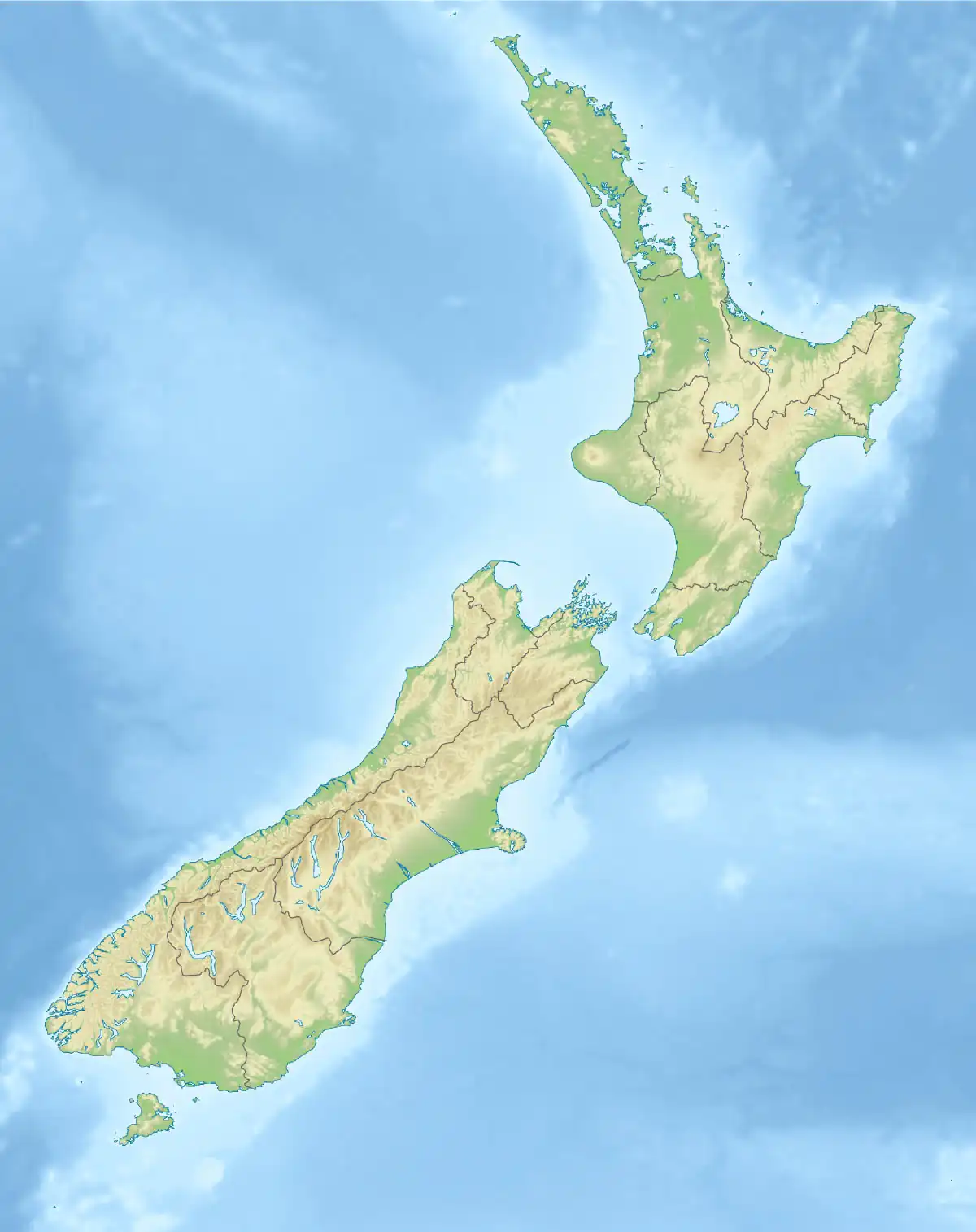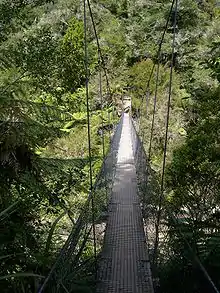| Abel Tasman National Park | |
|---|---|
 | |
 Map of New Zealand | |
| Location | Tasman District, New Zealand |
| Nearest city | Motueka |
| Coordinates | 40°50′S 172°54′E / 40.833°S 172.900°E |
| Area | 237.1 km2 (91.5 sq mi) |
| Established | 1942[1] |
| Governing body | Department of Conservation |
Abel Tasman National Park is a New Zealand national park located between Golden Bay / Mohua and Tasman Bay at the north end of the South Island. It is named after Abel Tasman, who in 1642 became the first European explorer to sight New Zealand and who anchored nearby in Golden Bay.
Abel Tasman National Park is the smallest national park in New Zealand but has among the most visitors.[2] The Abel Tasman Coast Track, one of New Zealand's Great Walks, is a coastal tramping route spanning 60 kilometres (37 mi) along the eastern and northern coastal areas of the park.[3]
History
The coastal area was inhabited for hundreds of years by Māori prior to the arrival of Europeans, with sites throughout the area occupied both seasonally and permanently. In addition to harvesting food from the local forests, estuaries and waters, locals grew kumera.[4]
Historical records indicate a pā was established at Auckland Point by Pohea, who travelled there around 1450 from the Whanganui area. From the mid-1500's Muaūpoko (formerly known as Ngāi Tara[5]) occupied the area until the early 1600's, when they were ousted by Ngāti Tūmatakōkiri. Ngāti Tūmatakōkiri were present when Abel Tasman reached Golden Bay / Mohua in 1642.[6]
Park establishment
The park was founded in 1942, largely through the efforts of ornithologist and author Pérrine Moncrieff to have land reserved for the purpose. Moncrieff served on the park board from 1943 to 1974.[7]
The park was opened on the 18 December 1942 to mark the 300th anniversary of Abel Tasman's visit.[8] Those in attendance at the opening ceremony at Tarakohe included Charles van der Plas, as personal representative of the Netherlands' Queen, Wilhelmina. The Queen was made Patron of the park.[9]
The idea for the park had been under consideration since June 1938. The Crown set aside 15,225 hectares (37,622 acres), comprising 8,900 hectares (21,900 acres) of proposed state forest, 5,809 hectares (14,354 acres) of Crown land and 554 hectares (1,368 acres) of other reserve land for the national park.[10] The Golden Bay Cement Company donated the land where the Abel Tasman Monument and a memorial plaque was sited.[8] The area's primary historic interest was the visit of Tasman in 1642, D'Urville in 1827, and the New Zealand Company barques Whitby and Will Watch, and brig Arrow in 1841. The site was also of significant botanical interest.[10]
Expansion
By 1946 the park had reached 15,534 hectares (38,386 acres) in area with additional land purchases. A further 844 hectares (2,085 acres) at Tōtaranui, formerly owned by William Gibbs, was acquired from J S Campbell in 1949 and added to the park.[11] About 6,100 hectares (15,000 acres) have been added since. In 2008 an extra 7.9 km2 (790 ha; 3.1 sq mi), including the formerly private land known as Hadfields Clearing, were added to the park.[12]
Geography
Location and size

Covering an area of 237 km2 (92 sq mi; 59,000 acres),[13] the park is the smallest of New Zealand's national parks.[4] It consists of forested, hilly country to the north of the valleys of the Tākaka and Riwaka Rivers, and is bounded to the north by the waters of Golden Bay / Mohua and Tasman Bay. The park contains some of the islands off the coast including the Tata Islands in Golden Bay / Mohua, and Tonga Island, Motuareronui / Adele Island, and Fisherman Island in Tasman Bay.[1]
The park does not extend beyond Mean High Water Mark on the adjacent coast. Between Mean High Water and Mean Low Water Springs, the beaches are gazetted as a Scenic Reserve, covering 7.74 km2 (2.99 sq mi) in total. The Tonga Island Marine Reserve adjoins part of the park.
The Abel Tasman Monument, though not located in the park, commemorates the first contact between Europeans and Māori and is located near the northern end of the park.
Ecology
Abel Tasman National Park stands out from most other National parks of New Zealand, given that a large area of it has undergone extensive environmental modification in its history. Early European settlers burned or cleared much of the forest, only to find that the soil was unsuitable for farming. This practise not only destroyed much of the shrubland and forests, but also introduced invasive plants found throughout the modern-day park. However, as time progresses, the original ecosystems and forests are slowly returning.[14]
The park contains varied habitats, including coastal forests, sub-alpine bogs, and sand dunes. As a result of this diversity, many different species can be found. The islands of the park, in particular Tonga Island, Motuareronui / Adele Island and Fisherman Island which are the largest, have been disturbed less and have no introduced mammalian predators. As a result the islands have species not found elsewhere in the park and there are more restrictions to visitor access.[4]
Flora
Though much of the parkland is pasture or covered with shrubs, valley areas contain forests of rātā, mataī, miro and hinau.[15]
Fauna
Over 70 species of birds have been recorded in the park. Some of the birds that can frequently be seen are petrels, shags, penguins, gulls, terns, and herons. Possums, wild pigs, deer, and goats can also be seen in the park.[1]
Conservation and human interaction
Activities and access
The Abel Tasman Coast Track is a popular tramping track that follows the coastline and is one of the Department of Conservation's Great Walks; the Abel Tasman Inland Track is less frequented. Other walks in the park, such as the Wainui Falls Track are considered 'short walks'.[16] Kayaking, camping and sightseeing are other activities.
Access to the park is usually via the small settlement of Mārahau[17] or Kaiteriteri (by water taxi). The nearest large town is Motueka, 20 kilometres (12 mi) to the south. Dogs (excepting guide dogs) are not allowed in the park.[4]
Management
The Department of Conservation administers the National Park. The Scenic Reserve is administered by the Tasman District Council Chief Executive and Department of Conservation’s Nelson / Marlborough Conservator. Activities in adjoining coastal waters are Tasman District Council's responsibility. These areas operate under separate regulations.
Management of the national park is divided into three types of "places", where visitor access and use differs between type:[18][2]
- The Coast, making up the coastal margin along the eastern side of the park inland to within 500 m of the Abel Tasman Coast Track. Management priorities include, but are not limited to, restoring wetlands and dune areas, preserving threatened plants, controlling pests, and advocacy related to land adjacent to the park. Other activities pertain to coastal access points and facilities for trampers and visitors.
- The Interior, consisting of the park areas further inland. Park plans include ecological surveys, pest control, and protection of heritage areas and caves.
- The Islands, encompassing all islands within the park, some of which are closed to the public. key priorities include keeping them free of invasive pests, reintroducing native species, and minimizing human impacts.
 Abel Tasman National Park from the air
Abel Tasman National Park from the air Tōtaranui is a 1 km long beach and the location of a large campsite.
Tōtaranui is a 1 km long beach and the location of a large campsite. Swingbridge on the track
Swingbridge on the track Wainui Falls, at the end of a short walk that begins in Wainui Bay.
Wainui Falls, at the end of a short walk that begins in Wainui Bay.
Project Janszoon
In 2012 Project Janszoon, a privately funded trust, was set up to restore the park's ecosystems. The trust takes its name from Tasman's middle name Janszoon. It is aiming to complete the restoration in time for the 400th anniversary of Tasman's visit and the park's 100th anniversary in 2042.
The Department of Conservation and Project Janszoon developed a free virtual visitor centre for downloading to smartphones or tablets. The application provides information about the Park's history, its flora and fauna, points of interest, weather, walking tracks, and tides.[19] This virtual visitor centre is free of charge and can be found through the App Store or Google Play Store.
See also
References
- 1 2 3 Hoiberg, Dale H., ed. (2010). "Abel Tasman National Park". Encyclopædia Britannica. Vol. I: A-ak Bayes (15th ed.). Chicago, Illinois: Encyclopædia Britannica Inc. pp. 25. ISBN 978-1-59339-837-8.
- 1 2 "Abel Tasman National Park Management Plan" (PDF). Nelson/Marlborough Conservancy Factsheet 173, New Zealand Government. November 2008.
- ↑ "Abel Tasman Coast Track". www.doc.govt.nz. Retrieved 13 January 2024.
- 1 2 3 4 "Abel Tasman National Park". Department of Conservation, Te Papa Atawhai.
- ↑ Reid, Darren. "Muaūpoko". The Encyclopedia of New Zealand: teara.govt.nz.
{{cite web}}: CS1 maint: url-status (link) - ↑ Smith, Dawn (1997). Abel Tasman Area History. Nelson: Department of Conservation: Te Papa Atawhai. ISBN 0-478-01905-X.
- ↑ Taonga, New Zealand Ministry for Culture and Heritage Te Manatu. "Moncrieff, Pérrine". Retrieved 20 December 2016.
- 1 2 Historic Event, Evening Post, Wellington| volume=CXXXIV| issue=127, 25 November 1942, Page 3
- ↑ Tasman Tercentenary, Evening Post| volume=CXXXIV| issue=144, 15 December 1942, Page 4
- 1 2 Memory of Tasman A new National Park, Evening Post| volume=CXXXIV| issue=147, 18 December 1942, Page 4
- ↑ Appendix to the Journals of the House of Representatives, 1949 Session I, C-10 Page 4
- ↑ "National Parks gain ground". press release. New Zealand Government. 20 March 2008. Archived from the original on 17 October 2008. Retrieved 26 March 2008.
- ↑ "Data Table - Protected Areas - LINZ Data Service". Land Information New Zealand. Retrieved 18 October 2017.
- ↑ Abel Tasman National Park Management Plan (PDF). Department of Conservation - Te Papa Atawhai. 2008–2018.
- ↑ "Abel Tasman National Park | Coastal Walks, Kayaking, Wildlife | Britannica". www.britannica.com. Retrieved 5 January 2024.
- ↑ "Wainui Falls Track". doc.govt.nz. Retrieved 9 January 2018.
- ↑ "Abel Tasman National Park Village - New Zealand". Retrieved 20 December 2016.
- ↑ "Abel Tasman National Park Management Plan". www.doc.govt.nz. Retrieved 5 January 2024.
- ↑ "janszoon.org". Retrieved 22 February 2015.
External links
- Information about the park, NZ Department of Conservation
![]() Abel Tasman National Park travel guide from Wikivoyage
Abel Tasman National Park travel guide from Wikivoyage